
Venice
Welcome to Venice
Everyone knows about the main attractions in Venice: St. Mark's Square with the Basilica, the Bell Tower and Doge's Palace, the Rialto Bridge, and the Grand Canal.
But Venice is also much more. It is a city where every canal, every street, and every square offer splendid views, with a wealth of history and art. The best way to enjoy Venice is to explore it on foot, get lost in the streets and fields, enter the artisan shops and eat in the small taverns and in the many bacari, as wine bars are called in Venetian.
Venice is part of an archipelago of islands, each with a unique beauty, even the least known, such as Torcello, Sant'Erasmo, Mazzorbo, Lazzaretto Nuovo, Certosa, Vignole, Pellestrina, and many others.
Our suggestions for a visit to Venice
St. Mark's Square
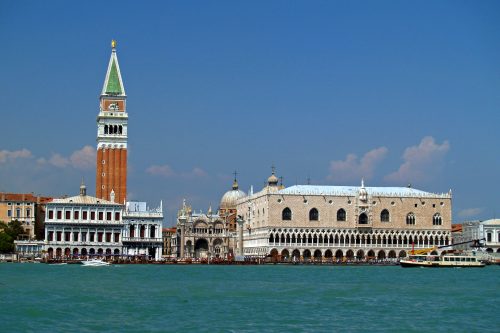 St. Mark's Square is the most famous place in Venice.
At the center of the square is St. Mark's Basilica, bathed in gold and covered with mosaics that tell the story of Venice, along with bas-reliefs depicting the months of the year.
Next to it stands the Doge's Palace, joined to the Basilica by the Porta Carta. The main entrance of the Palace is on the side overlooking the lagoon. The Palace was the seat of the government of the Serenissima and today is a museum that showcases the works by the best Venetian artists.
In front of the Doge's Palace stands the Bell Tower of San Marco, from the top of which you can enjoy a priceless view.
St. Mark's Square is the most famous place in Venice.
At the center of the square is St. Mark's Basilica, bathed in gold and covered with mosaics that tell the story of Venice, along with bas-reliefs depicting the months of the year.
Next to it stands the Doge's Palace, joined to the Basilica by the Porta Carta. The main entrance of the Palace is on the side overlooking the lagoon. The Palace was the seat of the government of the Serenissima and today is a museum that showcases the works by the best Venetian artists.
In front of the Doge's Palace stands the Bell Tower of San Marco, from the top of which you can enjoy a priceless view.Rialto and Grand Canal
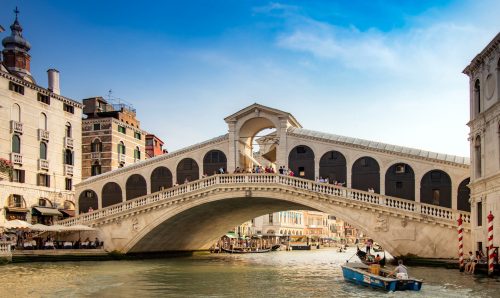 The Rialto Bridge is the oldest bridge that crosses the Grand Canal. Built in 1591, it was the only way to cross the canal on foot: in fact, it remained the only bridge until the mid-1800s.
It is also considered the king of Venetian bridges, because it is the largest. Along its staircase there are 24 shops, 12 on each side and at the top the opening on both sides allows you to see the Grand Canal in all its beauty.
The Grand Canal is the main canal that runs through the historic center of Venice and cuts the city into two parts. On its banks, ranging from the Ponte della Libertà to the basin of San Marco, there are magnificent historic buildings, a symbol of the power, wealth, and fervor from the artistic point of view of the Serenissima between the 12th and 18th centuries.
The Rialto Bridge is the oldest bridge that crosses the Grand Canal. Built in 1591, it was the only way to cross the canal on foot: in fact, it remained the only bridge until the mid-1800s.
It is also considered the king of Venetian bridges, because it is the largest. Along its staircase there are 24 shops, 12 on each side and at the top the opening on both sides allows you to see the Grand Canal in all its beauty.
The Grand Canal is the main canal that runs through the historic center of Venice and cuts the city into two parts. On its banks, ranging from the Ponte della Libertà to the basin of San Marco, there are magnificent historic buildings, a symbol of the power, wealth, and fervor from the artistic point of view of the Serenissima between the 12th and 18th centuries.Museums
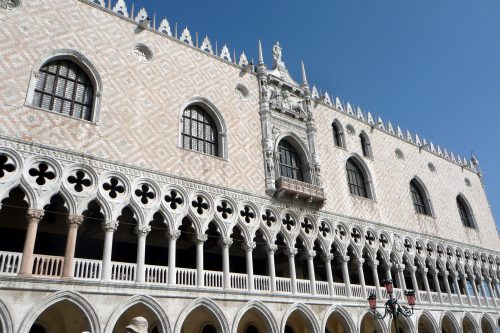 If you want to visit a museum in Venice, you are spoilt for choice.
The Foundation of the Civic Museums of Venice brings together some of the most important museums in the city. Among its 11 museums, we remember:
Doge's Palace: in St. Mark's Square and seat of the Doge of Venice. Here you can discover all the history of the Serenissima up to its decline and let yourself be fascinated by the superbly decorated interiors.
Correr Museum: born from the collection that Teodoro Correr left to the city in 1830, it is located in Piazza San Marco and is characterized by architecture, decorations, frescoes and neoclassical furniture.
Cà Rezzonico: seat of the Museum of the Venetian eighteenth century in the Dorsoduro district.
Cà Pesaro: in the quarter of Santa Croce, it is the International Gallery of Modern Art and Museum of Oriental Art.
Glass Museum: it is located on the island of Murano and presents a collection of historical pieces of Murano glass.
Other museums not to be missed are the Peggy Guggenheim Collection, Palazzo Grassi or the Venice Biennale.
If you want to visit a museum in Venice, you are spoilt for choice.
The Foundation of the Civic Museums of Venice brings together some of the most important museums in the city. Among its 11 museums, we remember:
Doge's Palace: in St. Mark's Square and seat of the Doge of Venice. Here you can discover all the history of the Serenissima up to its decline and let yourself be fascinated by the superbly decorated interiors.
Correr Museum: born from the collection that Teodoro Correr left to the city in 1830, it is located in Piazza San Marco and is characterized by architecture, decorations, frescoes and neoclassical furniture.
Cà Rezzonico: seat of the Museum of the Venetian eighteenth century in the Dorsoduro district.
Cà Pesaro: in the quarter of Santa Croce, it is the International Gallery of Modern Art and Museum of Oriental Art.
Glass Museum: it is located on the island of Murano and presents a collection of historical pieces of Murano glass.
Other museums not to be missed are the Peggy Guggenheim Collection, Palazzo Grassi or the Venice Biennale.Churches
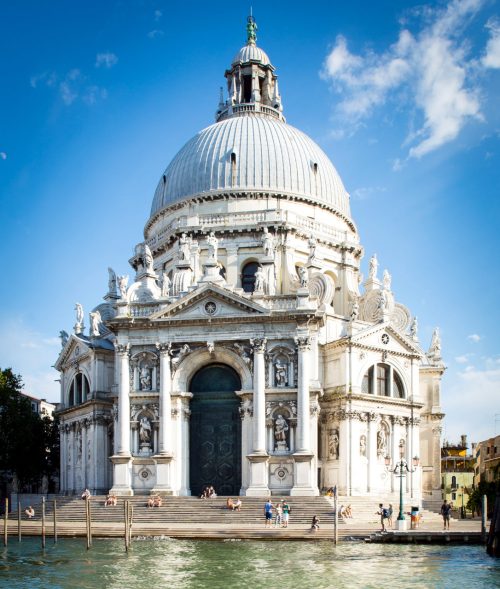 With 148 churches and 170 bell towers, the ancient saying, “In Venice there are more churches than Christians!” seems true.
Each of them is a small jewel full of extraordinary art treasures. Through the architecture, style, paintings, fabrics and gold decorations tell the millennial history of this city.
This prosperity of churches is due both to the doge and the patriarchate and to the nobles present in Venice: each family built its church, which had to be more beautiful and larger than the others.
Among the most important and beautiful churches in Venice we remember:
St. Mark's Basilica: cathedral of the city and seat of the Patriarch and the Patriarchate of Venice. Unique monument for the richness of its history and its majesty.
Basilica of Santa Maria della Salute: it is located in the Dorsoduro district. It is a seventeenth-century church built after the liberation of Venice from a plague epidemic, with an octagonal plan, with the dome that emerges from the Grand Canal.
Basilica of Saints John and Paul: here are 25 tombs of the Doges of Venice and is for this reason called the Pantheon of Venice. It is among the largest and most majestic in the city and many famous artists have helped to embellish the basilica with their works.
With 148 churches and 170 bell towers, the ancient saying, “In Venice there are more churches than Christians!” seems true.
Each of them is a small jewel full of extraordinary art treasures. Through the architecture, style, paintings, fabrics and gold decorations tell the millennial history of this city.
This prosperity of churches is due both to the doge and the patriarchate and to the nobles present in Venice: each family built its church, which had to be more beautiful and larger than the others.
Among the most important and beautiful churches in Venice we remember:
St. Mark's Basilica: cathedral of the city and seat of the Patriarch and the Patriarchate of Venice. Unique monument for the richness of its history and its majesty.
Basilica of Santa Maria della Salute: it is located in the Dorsoduro district. It is a seventeenth-century church built after the liberation of Venice from a plague epidemic, with an octagonal plan, with the dome that emerges from the Grand Canal.
Basilica of Saints John and Paul: here are 25 tombs of the Doges of Venice and is for this reason called the Pantheon of Venice. It is among the largest and most majestic in the city and many famous artists have helped to embellish the basilica with their works.Cannaregio
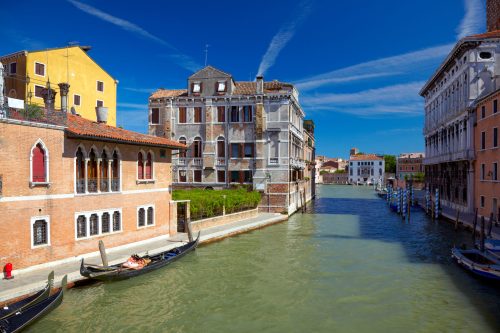 The Cannaregio district is one of the largest and most inhabited by venetians. It starts from the Santa Lucia train station and reaches Campo dei Miracoli.
It is one of the sestieri, as quarters in Venice are called, which still retains its popular character. It is traversed by small canals and an infinity of bridges. Getting lost in the small streets, you can discover the bacari where to stop for a good glass of wine and a snack.
Here it is easy to see the inhabitants of Venice returning from their daily errands by boat, children who go to school or who play in the squares near their homes and also the associations of voga alla veneta, Venetian style rowing, who train in the canals.
Going into Cannaregio you can discover the Jewish Ghetto with the synagogues and the museum, the Fondamenta Nove from which to enjoy a wonderful view of the island of San Michele, the cemetery of Venice, and the island of Murano, as well as Ca' D'Oro, one of the most beautiful buildings in Venice overlooking the Grand Canal.
The Cannaregio district is one of the largest and most inhabited by venetians. It starts from the Santa Lucia train station and reaches Campo dei Miracoli.
It is one of the sestieri, as quarters in Venice are called, which still retains its popular character. It is traversed by small canals and an infinity of bridges. Getting lost in the small streets, you can discover the bacari where to stop for a good glass of wine and a snack.
Here it is easy to see the inhabitants of Venice returning from their daily errands by boat, children who go to school or who play in the squares near their homes and also the associations of voga alla veneta, Venetian style rowing, who train in the canals.
Going into Cannaregio you can discover the Jewish Ghetto with the synagogues and the museum, the Fondamenta Nove from which to enjoy a wonderful view of the island of San Michele, the cemetery of Venice, and the island of Murano, as well as Ca' D'Oro, one of the most beautiful buildings in Venice overlooking the Grand Canal.Dorsoduro
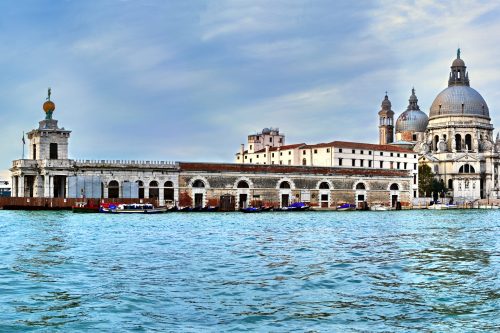 Its name derives from the hardness of the earth: Dosso Duro. Here you will find the Punta della Dogana and the Basilica of Santa Maria della Salute. It is a very quiet sestiere, perfect for a walk during the day to admire the various facets of Venice.
Bridges and bridges are not lacking and it is precisely getting lost in the streets that you can discover the increasingly rare squeri, or boatyards, places where gondolas are sheltered and built.
In the Dorsoduro district there is the Peggy Guggenheim Collection, Ca' Rezzonico and the Ca' Foscari university.
On the side of the Giudecca Canal, you can take a long, quiet and sunny walk that ends at San Basilio. Along its route you can enjoy an ice cream on the sea terraces of the many bars and ice cream parlors.
Its name derives from the hardness of the earth: Dosso Duro. Here you will find the Punta della Dogana and the Basilica of Santa Maria della Salute. It is a very quiet sestiere, perfect for a walk during the day to admire the various facets of Venice.
Bridges and bridges are not lacking and it is precisely getting lost in the streets that you can discover the increasingly rare squeri, or boatyards, places where gondolas are sheltered and built.
In the Dorsoduro district there is the Peggy Guggenheim Collection, Ca' Rezzonico and the Ca' Foscari university.
On the side of the Giudecca Canal, you can take a long, quiet and sunny walk that ends at San Basilio. Along its route you can enjoy an ice cream on the sea terraces of the many bars and ice cream parlors.San Polo
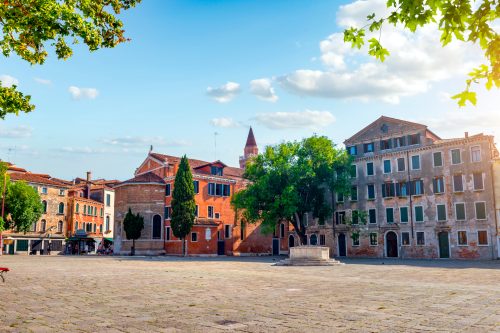 The San Polo district starts from the Rialto Bridge and is the smallest in Venice, but the one with the largest number of artisan shops, taverns and bacari where you can find typical dishes of Venetian cuisine and the typical cicheti, as local snacks are called, similar to Spanish tapas.
In addition to the Rialto area with its bridge and the Church of San Giacomo di Rialto, traditionally considered the oldest in Venice, the sestiere houses the Campo dei Frari, with the entrance to the huge State Archive of Venice, where the public and private writings of the life of the Doges and their subjects are collected in miles of shelves.
The San Polo district starts from the Rialto Bridge and is the smallest in Venice, but the one with the largest number of artisan shops, taverns and bacari where you can find typical dishes of Venetian cuisine and the typical cicheti, as local snacks are called, similar to Spanish tapas.
In addition to the Rialto area with its bridge and the Church of San Giacomo di Rialto, traditionally considered the oldest in Venice, the sestiere houses the Campo dei Frari, with the entrance to the huge State Archive of Venice, where the public and private writings of the life of the Doges and their subjects are collected in miles of shelves.The islands
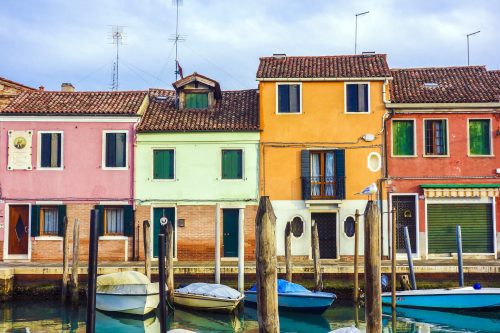 Don't miss the chance to visit the islands around Venice!
Easily accessible, you can spend a day in a very special world, among colorful houses, typical handicrafts and gardens.
In addition to well-known Murano, the island of glass, and Burano, the island of lace, there are also islands where you can go cycling along nature trails, ideal for families.
For example, the island of Sant’Erasmo is considered the historic vegetable garden of the Serenissima and can be visited on foot or by bicycle.
The island of Vignole offers picnics with stops in the typical taverns, the island of Torcello was the first inhabited island and hides the vestiges of the ancient splendor of the Venetian Republic.
The island of Pellestrina, composed of small villages of colorful houses and beaches frequented only by the inhabitants, has an incredible treasure: forty hectares of protected nature reserve, the LIPU Reserve of Ca' Roman.
Don't miss the chance to visit the islands around Venice!
Easily accessible, you can spend a day in a very special world, among colorful houses, typical handicrafts and gardens.
In addition to well-known Murano, the island of glass, and Burano, the island of lace, there are also islands where you can go cycling along nature trails, ideal for families.
For example, the island of Sant’Erasmo is considered the historic vegetable garden of the Serenissima and can be visited on foot or by bicycle.
The island of Vignole offers picnics with stops in the typical taverns, the island of Torcello was the first inhabited island and hides the vestiges of the ancient splendor of the Venetian Republic.
The island of Pellestrina, composed of small villages of colorful houses and beaches frequented only by the inhabitants, has an incredible treasure: forty hectares of protected nature reserve, the LIPU Reserve of Ca' Roman.